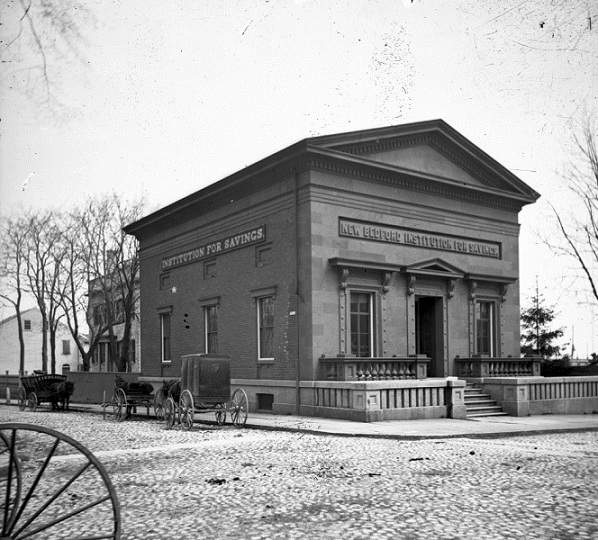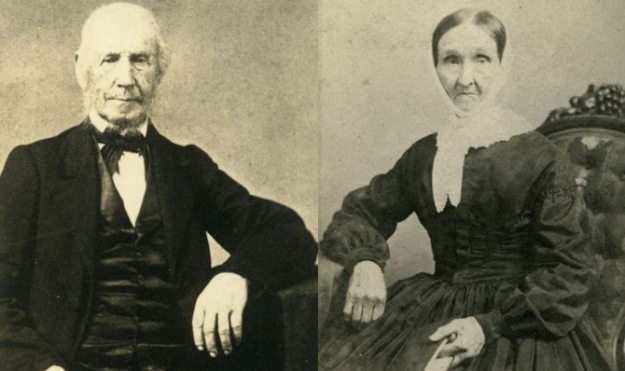Digging through historical documents and images as part of research for historical articles, I come across an inordinate amount of stories. Some are short, others need a novel to tell them. Some of these are “well-known” and others I have never seen or read elsewhere. When it comes to any information base on any topic -especially history- there are people who have varying amounts of knowledge. What may be well-known to one may not be to another – no matter how incredulous it may seem to he/she that is already in the know.
I mention this because I ask for a bit of liberty from that demographic that is already in the know on the topics I share. This is especially the case with Russell Warren’s historic New Bedford Institution for Savings, whose history we first mentioned in the The Grand Designs of Russell Warren; New Bedford Architecture article.

The New Bedford Institution for Savings is a building that has been around a long time and changed hands too many times to count. Because of this there are a lot of photographs of the building. Over the years the folks at Spinner Publications have been generous enough to allow us to share these and similar photographs. Without their thoughtfulness, these articles would simply not exist – exposing my writing for what it is. I need those photographs! Please consider patronizing this fantastic organization.
As mentioned above the New Bedford Institution for Savings was built by Russell Warren in 1853 in a Greek Revival style building, albeit without the columns that Warren seemed so fond of.
Let’s set the context of the time: Franklin Pierce became the 14th President of the United States, inheriting the position from Millard Fillmore. America was just near the end of its famed Gold Rush out West which helped drive one of its massive immigration rushes.
With the intent to construct a transcontinental railroad to expand trade opportunities, America would purchase a large part of southern New Mexico and southern Arizona under the Gadsden Purchase. In Massachusetts Abba Alcott would lead the charge to petition the Constitutional Convention to urge suffrage for women and voters along with 420 male delegates would reject all eight proposals from the state’s Constitutional Convention to alter the Massachusetts Constitution.
Only a year earlier in 1852, Herman Melville would meet Essex captain George Pollard in Nantucket for the first time. The Essex was of course the inspiration for his iconic Moby Dick novel, written just a year earlier.
Warren’s brick, granite and sandstone building was built in a time where the economy was burgeoning along with New Bedford’s population – which was 18,000 strong at that point. Whaling actually reached its economic peak in 1853, so New Bedford was at its height in terms of revenue generated from the whaling industry. In fact, it was considered the “Richest City in the Country.” This would be the year that the city would get gas light for the first time, and its first public library on Union Street. Parker Street Grammar school would open.
It was a safe time to operate a bank and the intention for this structure was as we all know to be the New Bedford Institution for Savings. Not to be confused with the New Bedford Institution for Savings which was headed by William A. Crapo and incorporated in 1825, on the corner of Union and Fourth Streets.

As mentioned before 1853, was the peak of the whaling industry and it began a decline. New Bedford has always had a knack for industries and has never been stubborn about evolving and jumping ship to the next one. While whaling declined, other industries grew. New Bedford latched onto the textile industry to maintain its economic environment.
The New Bedford Institution for Savings would decide it needed a larger building, so would relocate to 174 Union Street – today’s Oceanarium – in 1896.
When it was vacated the Bristol County Court System moved in and the structure became the Old Third District Courthouse as its pediment still silently declares today. The richest city in the world surely sounded good to any criminal element and it goes without saying that where there is money, there are crooks. This Old Third District Courthouse was simply too small to handle the criminal activities and had to relocate to larger facilities – which it did circa 1914.
After life as a courthouse, the NBIS building would become a variety of local businesses, including an antiques store and Johnson’s Auto Parts. It was added to the National Register of Historic Places in 1971. It would become a bank again in the 1990s as Fleet Bank. Fleet Bank teamed with WHALE, New Bedford’s Waterfront Historic Preservation LEague, and renovated the now almost 150 year old building. WHALE then bought the building from Fleet, who surely – once again – felt the building was too small.
WHALE then turned the building over to the National Park Service in 1995 and the building became the Visitor’s Center, which is a function it still serves today!
 New Bedford Guide Your Guide to New Bedford and South Coast, MA
New Bedford Guide Your Guide to New Bedford and South Coast, MA







